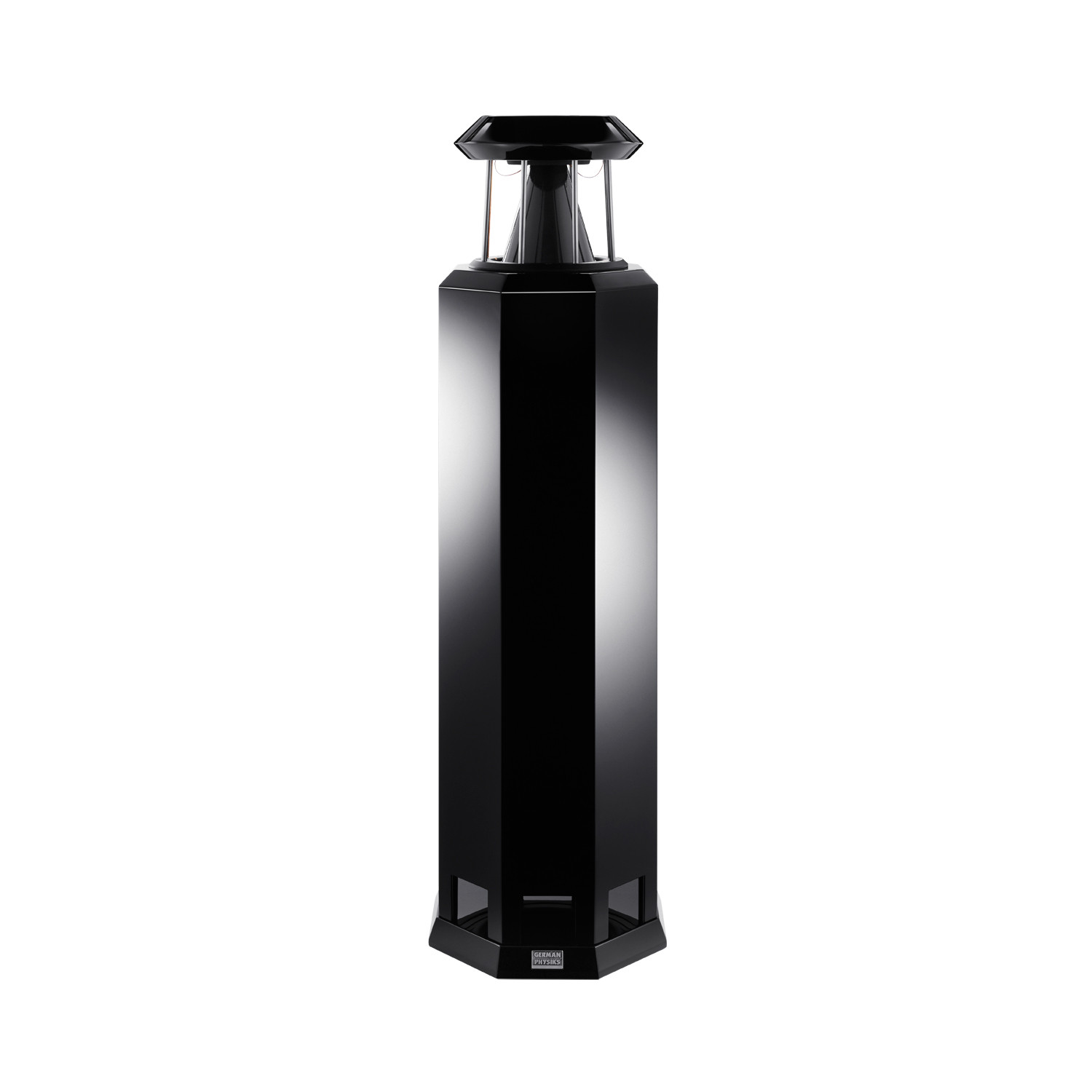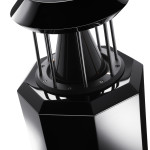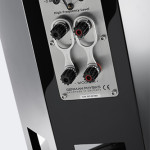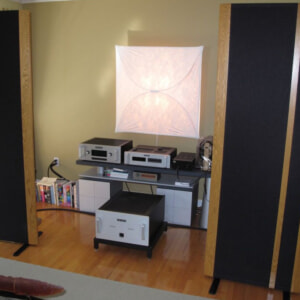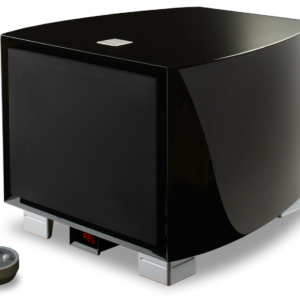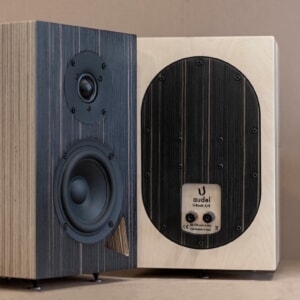THE HRS-130
The HRS-130 is an improved version of our popular HRS-120. Not only have significant improvements been made to the sound quality, but the cabinet has been restyled to give a smoother look, enabling the HRS 130 to blend more easily in to the room. The improved look is enhanced by a new, luxurious high-polish polyester finish, which is available in black or white.
The HRS-130 uses a single carbon fibre German Physiks DDD driver mounted on top of a slim, floor standing cabinet, with a downward firing woofer set in its base. These work seamlessly together to create a detailed, three-dimensional stereo image that immerses you in the music. The transparency of the DDD driver opens a new window on to your music collection, by helping to reveal fine detail and ambience information that you would normally only expect to hear at a live performance. Most important of all, the DDD driver’s exceptional transparency better allows you to experience the emotion that is the essence of a good musical performance.
Improved resolution and dynamics
The HRS-130 has a new crossover that provides improved resolution and dynamics. Now it is even easier to follow the various threads in a performance, even at high levels. This does not mean that the HRS-130 forces you to listen analytically, as you can also sit back and enjoy the performance as a whole if you wish.
New 10-inch bass driver
The HRS-130 uses a new 10-inch bass driver instead of the 8-inch driver employed by the HRS-120. This is the same unit that our much more expensive PQS-402 uses. It provides a deeper, better defined and more controlled bass. The integration of the bass with the rest of the frequency range has also been improved. It was good on the HRS-120 and on the HRS-130 it is better still.
The Revolutionary German Physiks DDD Driver
The key to the outstanding performance delivered by the HRS-130 is its carbon fibre DDD driver. This is an omnidirectional driver, which on the HRS-130 covers the range from 220Hz to 24kHz. This extremely wide range is achieved by the use of pistonic, bending wave and modal radiation: most loudspeakers use drivers that are purely pistonic. The same quality of DDD driver is used on all German Physiks loudspeakers, from our entry level Unlimited Mk II, to our top of the range Gaudi Mk II. The DDD driver gives the same very important advantages to all German Physiks designs and is what sets them apart from the competition.
1. Exceptionally coherent and natural sound: The extremely wide operating range of the HRS-130’s DDD driver provides an exceptionally coherent and natural sound. This is very difficult to achieve when this frequency range is split over two or more different types of driver. This wide operating range also eliminates the crossover point in the mid-range that loudspeakers using conventional pistonic drivers must have. Our hearing is most sensitive in the mid-range and avoiding the level and phase errors that crossovers can create from this region further improves transparency.
2. Realistic stereo images more like you experience in the concert hall: When you listen to music in a concert hall, you are in an enveloping sound field where a lot of the sound is reflected off a surface before it reaches your ears. These reflections play an important part in the creation the stereo image that you perceive. Because the DDD driver is omnidirectional, it radiates all frequencies evenly around it and so creates a similar enveloping sound field in the listener’s room. This way the HRS-130 is able to recreate a more natural rendition of the original stereo image. This has excellent depth and focus, but without the overly sharp image definition that some hi-fi loudspeakers produce and which you will rarely if ever hear at a live performance.
3. Stereo imaging enjoyable in almost all positions in the room: Conventional loudspeakers tend to produce stereo images that can only be best enjoyed from one position in the room, the “sweet-spot”, and then usually by only one person. Move away from the “sweet-spot” and both the stereo image and tonal balance become progressively degraded. This is because pistonic drivers tend to concentrate their radiation into a beam that narrows with increasing frequency.
By contrast, the DDD driver’s omnidirectional radiation pattern enables HRS-130 to produce excellent stereo images that can be enjoyed from a wide range of listening positions in the room, whilst also maintaining a more even tonal balance: much like you would experience at a live performance. This gives more flexibility in where you sit and allows several people to enjoy a good sound simultaneously, so you can share your music with others. Because you are not restricted to a small “sweet-spot” in order to hear the best sound, the HRS-130 provides a more relaxed listening experience. This is especially noticeable when you listen for long periods.
4. Exceptional dynamics: The DDD driver’s very low moving mass provides an excellent impulse response, allowing it to recreate both the attack of the music and resolve low level detail very accurately. This is essential in order to faithfully reproduce the delicate nuances of a performance and make it sound like music, rather than just good hi-fi. The resultant transparency is maintained even on complex high-level passages.
5. Accurate portrayal of musical instruments’ tonal characteristics: The DDD driver is phase linear across its operating range, ensuring that the tonal character of each musical instrument is reproduced with great accuracy. This together with the excellent dynamic response enables the HRS-130 to reproduce percussion with startling reality. Voices are also exceptionally realistically portrayed, with all the elements that comprise the vocal sound correctly located in space and with no undue emphasis. You get a greater sense of hearing a live musician rather than a recorded one.
More information on the DDD driver, its development and advantages may be found on the Technology page of this web site.
Quick and easy to set up
The DDD driver’s omnidirectional radiation pattern and wide operating frequency range make the HRS-130 less critical of its position in the room than conventional loudspeakers, so it is very quick and easy to set up. In addition, because the HRS-130 is omnidirectional, there is no toe-in adjustment to worry about. Last but not least, with a cabinet footprint of only 325mm x 325mm (12.8” x 12.8”), the HRS-130 is easy to fit into even a modest sized room. Don’t let this deceive you though, as the HRS-130 will drive rooms up to 75 square metres (580 sq ft) in size.
Low Resonance Cabinet Design
Resonances in a loudspeaker cabinet can seriously degrade the sound quality by obscuring detail. To counter this, the HRS-130, like our more expensive Borderland Mk IV, uses an octagonal cross-section cabinet. The panels on this cabinet are smaller and stiffer than those of an equivalent size square section cabinet would be. This reduces cabinet vibration, which would otherwise mask fine detail. Critically placed internal bracing further increases rigidity. In addition, a special damping material called Hawaphon® is applied to the inside of each panel. This very effectively converts vibration energy into heat. It also adds mass to the panel, ensuring that the residual cabinet vibration is extremely low.
High quality input terminals
The HRS-130 is fitted with two sets of WBT’s high quality nextgen™ loudspeaker terminals. This allows the HRS-130 to be bi-wired or bi-amped. High quality jumpers are supplied to enable the HRS-130 to be used with just one set of loudspeaker cables.
Adjustable High Frequency Output
Jumpers on the loudspeaker’s rear panel allow the high frequency output level to be adjusted in 4 steps: -2dB, flat, +2dB and +4dB, enabling the user to easily compensate for the variations in the absorption of high frequencies that can occur due to different types of furnishings and room construction.
Designed for a Lifetime of Use
The same quality of parts is used in the HRS-130 as we use in our reference products, where we design for a minimum life expectancy of 25 years. We also apply the same meticulous care and attention to the manufacture and testing of the HRS-130 as we do with all of our other products. For example, the DDD driver support pillars, loudspeaker terminal mounting plates and all the screws and spikes are made from high quality V4 stainless steel. This provides excellent corrosion resistance and ensures that the HRS-130’s high cosmetic standard will be maintained over the product’s lifetime.
Hand Finished for Ultimate Quality
The standard finish for the HRS-130 is high-polish polyester in black or white. It is also available in satin veneer, satin paint, high-polish veneer and carbon fibre finishes to special order. Please see the Finishes page on this web site for more details. To provide the ultimate level of quality, all our cabinets are carefully finished by hand.

